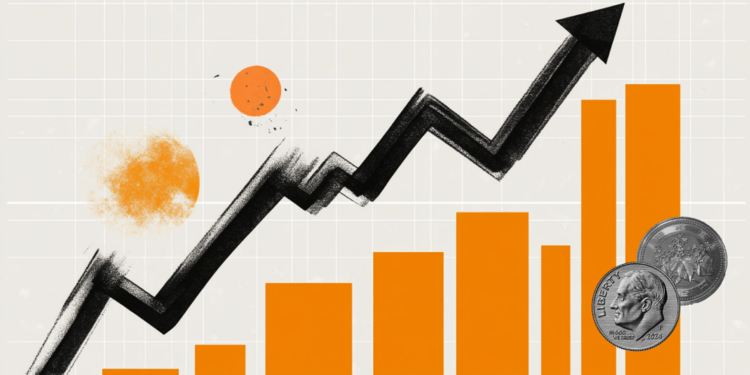- The US dollar continues to push higher after the encouraging ISM data on Wednesday.
- Surprise rate cut in Poland weakens ECB and BoE vis-à-vis the Fed.
- The DXY Dollar Index breaks above 105.00 but takes a small step back on Thursday.
The US dollar (USD) moved higher again on Wednesday as markets trembled and cracked on all sides. The bond market sees its yields soar again, with the US 10-year yield on track to break the monthly high at 4.36%.
Equities tumbled on Wednesday, with the S&P 500 breaking below the 55-day simple moving average (SMA). With the surprising 0.75% interest rate cut by the Polish Central Bank, analysts are further ramping up rate divergence trading, with US rates staying high for longer and Europe, the UK and Central European countries will have to cut faster and more aggressively to avoid a collapse of the economy.
Although the macroeconomic data on Wednesday was key and fundamental, there is nothing really important to look forward to this Thursday. Initial and continuing jobless claims may be worth watching for a sudden spike. Later, be prepared with no less than five speakers from the US Federal Reserve that could put an end to this summer rally in the Dollar Index.
Market Drivers: Dollar Faces Fed Speeches
- At around 12:30 GMT, the data calendar for the US kicks off with initial and continuing weekly jobless claims. The number of initial requests is expected to increase from 228,000 to 234,000 requests. As for the continued ones, they are expected to drop from 1,725,000 to 1,715,000.
- At the same time, the non-farm productivity figure for the second quarter will be released. A slight increase from 3.7% to 3.8% is expected. Unit Labor Costs are not expected to rise further and should hold steady at 1.6%.
- A full line of speakers from the US Federal Reserve: Patrick Harkers from Philadelphia will kick off at 14:00 GMT. The next Fed member, Chicago’s Austan Gooldsbee, will speak at 15:45 GMT. At 19:30 GMT John Williams from New York and Raphael Bostic from Atlanta will speak. Michelle Bowman will deliver the final Fed member speech this Thursday around 20:55 GMT.
- Stocks in Asia are assuming the negative mood in which the US closed on Wednesday. The Hang Seng Index is down more than 1% at Thursday’s close. For their part, European stocks are firmly in the red, but containing losses.
- The CME Group’s FedWatch tool shows that markets are pricing in a 93% chance that the Federal Reserve will keep interest rates unchanged at its September meeting.
- The 10-year US Treasury yield is trading at 4.29% and still rising after the US Treasury issued a large amount of debt on Tuesday. The auctions flooded the bidding markets and caused yields to rise.
DXY Dollar Index Technical Analysis: Reality Shift
Taking a step back from the recent turn of events, it is clear that a seismic shift has already occurred this week regarding monetary policy this year for several major central banks. The US Federal Reserve and the Bank of Canada are holding on to the higher interest rate timeline for longer, while Poland and the European Central Bank are seeing EU data show signs of crisis. This only fuels the divergence in rates between the two large geographical blocks. Expect the DXY Dollar Index to continue to rise in the fall, once the ECB and other Central European countries start cutting, while the Fed holds rates steady through 2023.
All eyes are on the 105.00 level after the DXY Index briefly broke through the level on Wednesday. There are only a few pips left before the DXY Index hits a new six-month high. The next levels are at 105.88, the March 2023 high, which would be a new yearly high. If the index reaches this last level, some resistance could appear.
To the downside, the 104.30 level is vital to keep the DXY Dollar Index at these elevated levels. A bit further down, the 200-day SMA at 103.06 comes into play, which could lead to further weakness once the DXY Index starts trading below it. Double support at 102.42, with the 100-day and 55-day SMAs, are the last lines of defense before the US dollar sees substantial, longer-term depreciation.
Frequently Asked Questions about the US Dollar
What is the US dollar?
The US dollar (USD) is the official currency of the United States of America, and the “de facto” currency of a significant number of other countries where it is in circulation along with local banknotes. According to 2022 data, it is the most traded currency in the world, with more than 88% of all global foreign exchange operations, which is equivalent to an average of 6.6 trillion dollars in daily transactions.
After World War II, the USD took over from the British Pound as the world’s reserve currency. For most of its history, the US dollar was backed by gold, until the Bretton Woods Agreement of 1971, when the gold standard disappeared.
How do the decisions of the Federal Reserve affect the dollar?
The single most important factor influencing the value of the US dollar is monetary policy, which is determined by the Federal Reserve (Fed). The Fed has two mandates: achieve price stability (control inflation) and promote full employment. Its main tool to achieve these two objectives is to adjust interest rates.
When prices rise too fast and inflation exceeds the 2% target set by the Fed, the Fed raises rates, which favors the dollar’s value. When inflation falls below 2% or the unemployment rate is too high, the Fed can lower interest rates, which weighs on the dollar.
What is Quantitative Easing and how does it influence the Dollar?
In extreme situations, the Federal Reserve may also print more dollars and enact quantitative easing (QE). QE is the process by which the Fed substantially increases the flow of credit in a stuck financial system.
This is an unconventional policy measure that is used when credit has dried up because banks do not lend to each other (for fear of counterparty default). It is the last resort when a simple lowering of interest rates is unlikely to achieve the necessary result. It was the weapon of choice for the Fed to combat the credit crunch that occurred during the Great Financial Crisis of 2008. It consists of the Fed printing more dollars and using them to buy US government bonds, mainly from financial institutions. QE usually leads to a weakening of the US dollar.
What is Quantitative Tightening and how does it influence the US Dollar?
Quantitative tightening (QT) is the reverse process whereby the Federal Reserve stops buying bonds from financial institutions and does not reinvest the principal of maturing holdings in new purchases. It is usually positive for the US dollar.
Source: Fx Street
I am Joshua Winder, a senior-level journalist and editor at World Stock Market. I specialize in covering news related to the stock market and economic trends. With more than 8 years of experience in this field, I have become an expert in financial reporting.







